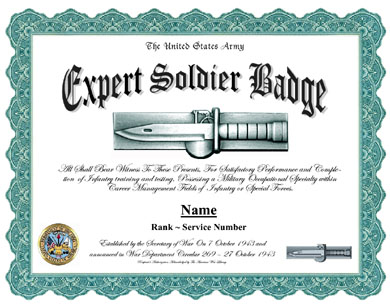 |
Expert Soldier Badge
Display Recognition![]()
Site Index
 |
Expert Soldier Badge
Display Recognition![]()
Site Index
Example Display Recognition:
Actual Size: 8 1/2 x 11

![]()
Military Branches
Army
![]()
You have four display types to choose from:
Black & White (No Color)
Heavy Bond Enclosure
 |
Heavy Bond Enclosure Colors: Regal, Black, Navy Trimmed in Appearance Gold Ready for Mantle or Shelf Display |
|---|
![]()
You must submit the following document displaying your Expert Badge:
An unaltered photocopy of your...This Display Recognition is available ONLY to authorized recipients who possess orders, or authorization form, or release documentation that confirms award eligibility. (See "Issue Requirements"). To obtain either a Display Medal or a Display Recognition for your authorized award you will be required to provide military-issued documentation authorizing your award. There are no exceptions. You must NOT submit a military issued document or photocopy that:
|
Personnel Branch
Processing and Delivery
| Style | Admin | Shipping | Total | Full Color .PDF (Printable) | $7.50 | Emailed | $7.50 | Published Document only (Full Color) | $14.00 | $12.11 USPS | $26.11 | Published Document in Heavy Bond Enclosure (Full Color) | $19.00 | $12.11 USPS | $31.11 |
|---|
You may apply for your Display Recognition using a...
(* Upon reception of required documentation)
Complete and MAIL this APPLICATION FORM.
Don't forget to include an unaltered COPY of your WD AGO 53-55 or other pre-arranged document(s).
![]()
Click here for answers to common questions
Email: Expert Soldier Badge Display Recognition InquiryTelephone: 1-562-422-4100 (Pacific Time Zone)
![]()
Copyright © ![]() The American War Library
The American War Library
Military and Veteran Websites
The G.I. Photograph Museum of Honor
Locator Registry Applications
Accessing The Worldwide Military Personnel Database
![]()
Issue Regulations
Expert Soldier Badge

Click for larger image
The ESB allows commanders to recognize Soldiers outside the Infantry, Special Forces and medical communities who have met a high standard of performance in physical fitness and warfighting tasks.
The ESB is designed to improve lethality, recognize excellence in Soldier combat skills and increase individual, unit and overall Army readiness. The ESB is the equivalent of the Expert Infantry Badge and Expert Field Medical Badge but for all other military occupational specialties in the Army. Those in the Infantry, Special Forces, and Medical career management fields are not eligible for the ESB.
Earning the badge will test a Soldier's proficiency in physical fitness, marksmanship, land navigation and other critical skills, and demonstrates a mastery of the art of soldiering.
The ESB training and testing is extremely challenging, mission-focused, and conducted under realistic conditions.
Under the ESB test process, Soldiers will demonstrate mastery of individual skills through different evaluations over a five-day period. The standards for the ESB place candidates under varying degrees of stress that test their physical and mental abilities as they execute critical tasks to an established set of standards.
The test consists of day and night land navigation, individual testing stations, and culminates with a 12-mile foot march. ESB test stations include warrior tasks laid out in the ESB regulation and may also include five additional tasks selected by the brigade commander from the unit's mission essential task list. Example tasks include:
TRAINING COURSE:
Medical Lane Tasks
M1: Request Medical Evacuation
M2: Provide Care Under Fire and Move a Casualty
M3: Provide First Aid to Restore Breathing and/ or Pulse
M4: Evaluate a Casualty for a Heat Injury
M5: Control Bleeding
M6: Evaluate and Treat a Casualty for a Spinal Injury and Shock
M7: Apply an Occlusive Dressing and Perform a Needle Chest Decompression
M8: Perform First Aid on an Open Head Wound in a CBRN Environment
M9: Treat an Open Abdominal Wound and Eye Injuries
M10: Treat a Fracture and a Burn
Weapon Lane Tasks
W1 : Carbine/Rifle and Light Grenade Launcher
Part One-M4 Carbine/M16 Rifle
Part Two-Light Grenade Launcher (M203 or M320)
W2-M249 Squad Automatic Weapon
Part One- Maintain the M249
Part One- Maintain the M240
Part Two- Operate the M249
Part Two- Operate the M240
W3-M240 Machine Gun
W4-M2. 50 Caliber Machine Gun
W5-MK 19 Heavy Grenade Launcher
W6-Pistol (M9 or M17)
W7-Hand Grenades
ESB 1: React to IED Attack
ESB 2: Construct Individual Fighting Position
ESB 3: Search Individual in a Tactical Environment
Patrol Lane Tasks
P1- Move under Direct Fire
P2- Tactical Handheld Radio
P3- Defense Advanced GPS Receiver (DAGR) Operations
P4- Camouflage and Visual Signaling Techniques
P5- Chemical and Biological Operations
P6- Resection and Military Maps
P7- M18A1 Claymore Mine (Electrical/Non-electrical Initiation)
P8- Transmit a Spot Report with a Tactical Man Pack Radio
ESB 4: Employ Progressive Levels of Individual Force
ESB 5: Mark CBRN-Contaminated Areas
Brigade Commanders choose from ESB tasks or 5 unit specific tasks such as "Rig a rucksack" or "PMCS a vehicle" (Approved through Test Management Office)